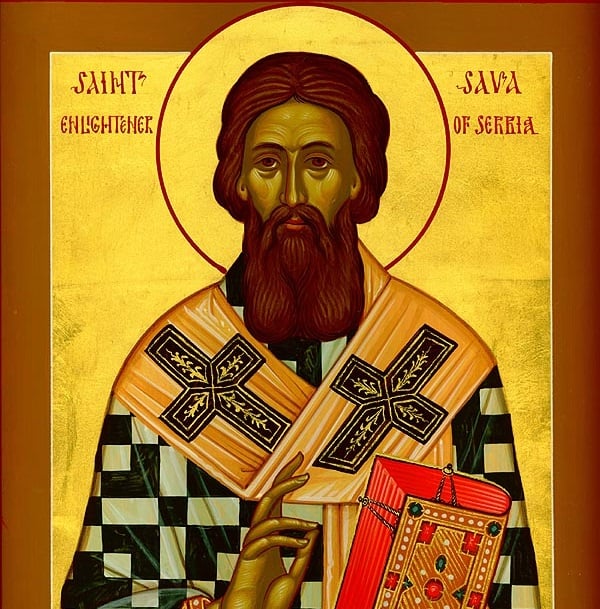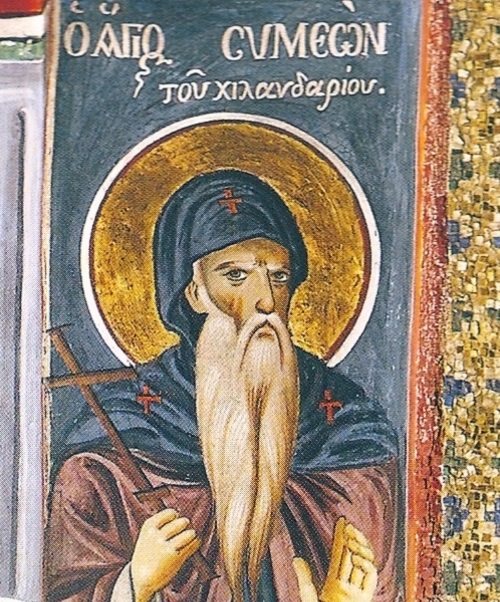Saints Sabbas, Archbishop of Serbia, and Symeon, his father
26 January 2017St Sabbas, the first Archbishop of Serbia, and his father, St Symeon the ‘Myrrhobletes’*, are two of the greatest saints of the Serbian Church. They lived in the second half of the 12th and the first half of the 13th centuries.
St Sabbas was the youngest son of the ruler of the Serbs Stephen Nemanja. Born in 1169, his secular name was Rastko. Both his mother, Anna, a Greek by birth, and his father took care to infuse into the soul of the young Rastko piety, faith and love of God by bringing him up in accordance with Orthodox tradition. Although endowed with many gifts, the soul of the young Rastko found no tranquillity among the comforts and riches of the royal palace. Day by day his heart became more inflamed by a love and unquenched thirst for Christ.

Thus at the age of 16, following a Russian monk, he secretly left his parents and made his way to the Holy Mountain, where he was tonsured at the Monastery of St Panteleimon, taking the name of Sabbas. In spite of the persistent attempts of his parents to persuade him to return to Serbia, the young monk Sabbas refused, remaining unyieldingly faithful to his monastic vows.
When on one occasion, together with other monks, he visited the famous Vatopaidi Monastery, he was so impressed by its order and way of life that when the Abbot and Brotherhood of the Monastery, together with the Protos of the Holy Mountain, urged him to take up residence there, he agreed with the greatest of pleasure. At Vatopaidi he became the junior of a humble and holy elder, the priest-monk Macarius, and threw himself into the battles of the ascetic life with all the fervour of his soul.
In the meantime, his parents, together with their letters, in which they begged Sabbas to go to Serbia even for a little while, so that they could see him, sent large sums of money and many gifts specifically for Vatopaidi. A part of this money he gave to the poor and the rest he made available for the erection of churches and of two and three-storey buildings at the Monastery. Because of all the buildings for which he was responsible, he was called the second founder of Vatopaidi.
To the letters which his parents had sent him, St Sabbas replied that he did not consider it right to abandon his monastery in order to visit them. Instead, he told his father that if he wanted to see him and enjoy his presence, he should abandon his throne and his wealth and agree to live with him as a monk far from the world and its clamour.
Sabbas’s earnest letter called forth a most profound response in the devout soul of his father, who soon after took the great decision. He left the throne to his youngest son, Stephen, and went with his wife, Anna, to the Studenitsa Monastery, which he himself had built. There both of them entered the monastic life, he taking the name of Symeon, and she that of Anastasia. Symeon stayed a little while at Studenitsa, before setting out for the Holy Mountain, taking with him many gifts and sacred vessels.
When he reached Vatopaidi, he was received with great honours by the Abbot and Brotherhood of the Monastery. His meeting with his beloved son, whom he embraced and kissed with tears of joy and gratitude, was a scene of great drama. News of his arrival spread rapidly throughout Athos, and large numbers of monks and abbots, together with the Protos, and even hermits, came to see St Symeon for themselves.
When, somewhat later, the two monks heard that there was at the land entrance to the Holy Mountain a ruined monastery with a church dedicated to the St Simeon who took Christ in his arms, they undertook its restoration. They built the church and a large tower with a protecting wall all round and presented it to Vatopaidi.
Later again, when St Sabbas visited Constantinople, he requested and received from the Emperor Alexius Comnenus as a gift for himself and his father a ruined monastery known as Chelandari, with a view to handing it over to Vatopaidi, which they did. A litte later, however, at the suggestion of a wise elder, they asked permission from the Abbot to restore the ruined monastery of Chelandari, so that it should serve as a monastery for monks from their own country. After some initial hesitation, the Abbot finally agreed to give them Chelandari for this purpose and it was decided that Vatopaidi and Chelandari should be as one monastery. In fact, Sts Sabbas and Symeon repaired the ruined church and built a wall round it, together with a high tower and large numbers of cells for the monks relatively rapidly.

A year after the completion of the work on the monastery, St Symeon departed this life. His tomb exuded an aroma of myrrh, and he was immediately recognised as a saint. His feast day is on the 18 February.
After the death of his father, St Sabbas, on the prompting of the Protos, was ordained priest and received the rank of archimandrite. At the request of his brother Stephen, Prince of Serbia, he took his father’s bones to Studenitsa, and, having spent a little time in Serbia performing his priestly duties, preaching and working miracles, he returned to the Holy Mountain to continue his life of asceticism.
But it was God’s design that he should return once again to his people, to serve them as leader of their Church. When in 1219 he visited Nicaea, which was then the seat of the Byzantine Emperor and the Patriarch, St Sabbas was, at their request and in spite of his own reservations, consecrated Archbishop of Serbia. With his headquarters at Zitsa, he organised the Church of Serbia, grounding it firmly in the Faith and in Orthodoxy, and enriching it with churches and worthy bishops and clergy.
On his return from the second of two pilgrimages which he made to the Holy Land, he fell ill in the Bulgarian city of Tirnovo, when he breathed his last on 13 February 1236. His body was buried there, but a year later was taken to the Milesevo Monastery in Serbia, where it remained until 1594.
Because the enslaved Christians resorted to his sacred relics and found comfort and hope and were cured of their illnesses, the Turks began to seek an occasion to rid themselves of them. For this reason, after the uprising of the Serbs in Banat in 1594, in which they had the icon of St Sabbas on their flags, the leader of the Turkish army, Sinan Pasha, ordered the relics of the Saint to be taken to Belgrade, where they were burnt on 27 April 1594.
The feast day of St Sabbas is on 13 January1.






